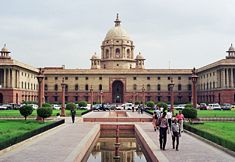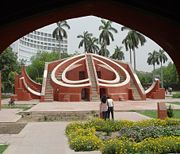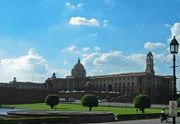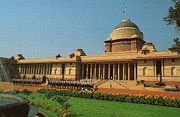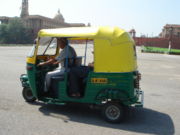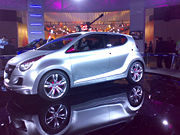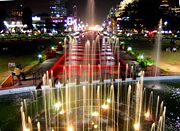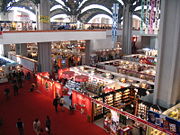New Delhi
2008/9 Schools Wikipedia Selection. Related subjects: Asia; Asian Cities
| ?New Delhi National Capital Territory of Delhi • India |
|
|
|
|
|
|
|
| Coordinates: | |
| Time zone | IST ( UTC+5:30) |
| Area • Elevation |
42.7 km² (16 sq mi) • 216 m (709 ft) |
| District(s) | New Delhi |
| Population • Density |
321,883 (2006) • 9,294 /km² (24,071 /sq mi) |
| Chief Minister | Sheila Dikshit |
| Codes • Pincode • Telephone • Vehicle |
• 110 xxx • +011 • DL-0? |
| Website: www.ndmc.gov.in | |
Coordinates:
New Delhi (Hindi: नई दिल्ली, Punjabi: ਨਵੀਂ ਦਿੱਲੀ, Urdu: نئی دلی) is the capital city of India. With a total area of 42.7 km2, New Delhi is situated within the metropolis of Delhi and serves as the seat of the Government of India and the Government of the National Capital Territory of Delhi.
Planned by Edwin Lutyens, a leading 20th century British architect, New Delhi is known for its wide, tree-lined boulevards and houses numerous national institutions and landmarks as well.
History
Calcutta was the capital of India until 1911 during the British Raj. However, Delhi had served as the political and financial centre of several empires of ancient and medieval India, most notably of the Mughal Empire. During the early 1900s, a proposal was made to the British administration to shift the capital of the Indian Empire from Calcutta to Delhi. Unlike Calcutta, which was located on the eastern coast of India, Delhi was located in northern India and the Government of British India felt that it would be easier to administer India from Delhi rather than from Calcutta. George V, the then Emperor of India, made the announcement the capital of the Raj was to be shifted from Calcutta to Delhi.
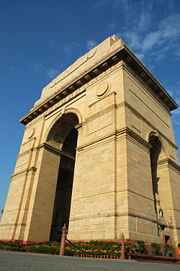
New Delhi was laid out to the south of the Old City which was constructed by Mughal Emperor Shah Jahan. However, New Delhi overlays the site of seven ancient cities and hence includes many historic monuments like the Jantar Mantar and the Lodhi Gardens.
Much of New Delhi was planned by Edwin Lutyens, a leading 20th century British architect and it has been dubbed " Lutyens' Delhi". Lutyens laid out the central administrative area of the city as a testament to Britain's imperial pretensions. At the heart of the city was the magnificent Rashtrapati Bhawan (then known as Viceroy's House) which sat atop Raisina Hill. The Rajpath, also known as King's Way, stretched from the India Gate to the Rashtrapati Bhawan. The Secretariat which houses various ministries of the Government of India, flanked out of the Rashtrapati Bhawan. The Parliament House, designed by Herbert Baker, is located at the Sansad Marg, which runs parallel to the Rajpath.
After India gained independence in 1947, a limited autonomy was conferred to New Delhi and was administered by a Chief Commissioner appointed by the Government of India. In 1956, Delhi was converted into a union territory and eventually the Chief Commissioner was replaced by a Lieutenant Governor. The Constitution (Sixty-ninth Amendment) Act, 1991 declared the Union Territory of Delhi to be formally known as National Capital Territory of Delhi. A system of diarchy was introduced under which the elected Government was given wide powers, excluding law and order which remained with the Central Government. The actual enforcement of the legislation came in 1993.
Geography

New Delhi lies in northern India, almost entirely in the Gangetic plains. New Delhi was once a part of the Aravalies, but all that is left now is the Delhi ridge, the first prominent geographical feature. The second feature is the Yamuna floodplains; New Delhi lies west of the Yamuna river, although for the most part, New Delhi is a landlocked city. East of the river is the urban area of Shahdara. New Delhi falls under the seismic zone-IV, making it vulnerable to major earthquakes.
New Delhi and its vicinity have a somewhat exaggerated continental climate due to its distance from the coasts and location with respect to mountain ranges. The temperature varies from 40 degrees Celsius in summers to around 4 degrees Celsius in winters. Delhi has a semi- arid climate with high variation between summer and winter temperatures. Summers are long, from early April to October, with the monsoon season in between. Winter starts in November and peaks in January. The annual mean temperature is 25 °C (77 °F); monthly mean temperatures range from 14 °C to 33 °C (58 °F to 92 °F). The average annual rainfall is approximately 714 mm (28.1 inches), most of which is during the monsoons in July and August.
Government
As of 2005, the government structure of the New Delhi Municipal Council includes a chairperson, three members of New Delhi's Legislative Assembly, two members nominated by the Chief Minister of National Capital Territory of Delhi (NCT) and five members nominated by the central government. The current Chief Minister of the NCT is Sheila Dikshit.
New Delhi is governed by its own municipal government, known as the New Delhi Municipal Council. Other urban areas of the metropolis of Delhi are administered by the Municipal Corporation of Delhi and are hence not considered a part of the capital city. However, the entire metropolis of Delhi is commonly known as New Delhi in contrast to Old Delhi.
Urban structure
Much of New Delhi was planned by Edwin Lutyens, a leading 20th century British architect and has been dubbed "Lutyens' Delhi". Lutyens laid out the central administrative area of the city as a testament to Britain's imperial pretensions. New Delhi is structured around two central promenades called the Rajpath and the Janpath. The Rajpath, or King's Way, stretches from the Rashtrapati Bhavan to the India Gate. The Janpath, formerly Queen's Way, begins at Connaught Circus and cuts the Shantipath at right angles.
At the heart of the city is the magnificent Rashtrapati Bhavan (formerly known as Viceroy's House) which sits atop Raisina Hill. The Secretariat, which houses various ministries of the Government of India, flanks out of the Rashtrapati Bhavan. The Parliament House, designed by Herbert Baker, is located at the Sansad Marg, which runs parallel to the Rajpath.
Transport
Public transport in New Delhi is provided by buses, auto rickshaws, a rapid transit system, taxis and suburban railways.
Metro
The Delhi Mass Rapid Transit System; a world class metro service, has been instituted in New Delhi and in the rest of the metropolis. In order to meet the transport demand in Delhi, the State and Union government started the construction of a mass rapid transit system, including the Delhi Metro. As of 2007, the metro operates three lines with a total length of 65 km (40 miles) and 59 stations while several other lines are under construction.
Taxi & Rickshaw
Auto rickshaws are a popular mode of public transportation in New Delhi. They are usually coloured Green and Yellow and, like all other commmercial vehicles in the NCR, run on CNG. State permit Black and Yellow taxis can also be found dotting the city, but have relatively few takers. Another option is the Radio Taxi: luxurious sedans furnished with air-conditioner and GPS and GPRS technology enabled devices. Taxicabs though, are a distant second as compared to the popular auto rickshaws, owing to their high rates.
Bus
Buses are the most popular means of transport catering to about 60% of the total demand. The state-owned Delhi Transport Corporation (DTC) is a major bus service provider for the city and plays a crucial role in connecting it with the rest of the metropolis. The buses operate around 34 depots, and the inter-state buses operate from the three Inter State Bus Terminals in Kashmere Gate, Sarai Kale Khan and Anand Vihar. DTC coordinates with Delhi Metro to connect commuters in areas surrounding the metro stations. DTC is constantly upgrading its fleet from dilapidated buses to the new Low-Floor Buses supplied by TATA. These modern buses are equipped with electronic displays, automatic doors, and automatic transmission. These buses come in the Green(Non-AC) and Red(AC) variants, with the latter having been recently introduced.
Air
Indira Gandhi International Airport (IGI) is situated in South West Delhi and is the main airport serving New Delhi. In 2006–07, the IGI airport recorded traffic of more than 20.44 million passengers, making it the second busiest airport in South Asia. Palam Airport and Safdarjung Airport are the other airfields in Delhi used for general aviation purpose.
Suburban Railway
Railways served only 1% of the local traffic as of 2003. The headquarters of Indian Railways and the Northern Railway are situated in New Delhi. The New Delhi Railway Station serves as the main railway station for the city and is a major railway hub in northern India.
Road
Private vehicles account for 30% of the total demand for transport. At 1922.32 km of road length per 100 km², Delhi has one of the highest road densities in India. Delhi is well connected to other parts of India by five National Highways: NH 1, 2, 8, 10 and 24. Roads in Delhi are maintained by MCD (Municipal Corporation of Delhi), NDMC, Delhi Cantonment Board, Public Works Department (PWD) and Delhi Development Authority. he Auto Expo, Asia's largest auto show, showcases modern forms of public and private transport
Demographics
As of 2003, the total population of New Delhi was 295,000. A large portion of New Delhi is associated with governmental affairs. The National Capital Territory of Delhi, of which New Delhi is a part of, had a population of 14.1 million people making it the second largest metropolitan area in India after Mumbai. There are 925 women per 1000 men, and the literacy rate is 81.67%.
Hinduism is the religion of 82% of Delhi's population, of which New Delhi is a part. There are also large communities of Muslims (11.7%), Sikhs (4.0%), Jains (1.1%) and Christians (0.9%) in Delhi. Other minorities include Parsis, Buddhists and Jews.
Hindi is the principal spoken and written language of the city. Other languages commonly spoken in the city are English, Punjabi and Urdu. Linguistic groups from all over India are well represented in the city; among them are Maithili, Haryanvi, Kannada, Telugu, Bengali, Marathi and Tamil.
Culture
New Delhi is a cosmopolitan city due to the multi-ethnic and multi-cultural presence of the vast Indian bureaucracy and political system. The city's capital status has amplified the importance of national events and holidays. National events such as Republic Day, Independence Day and Gandhi Jayanti (Gandhi's birthday) are celebrated with great enthusiasm in New Delhi and the rest of India. On India's Independence Day ( 15 August) the Prime Minister of India addresses the nation from the Red Fort. Most Delhiites celebrate the day by flying kites, which are considered a symbol of freedom. The Republic Day Parade is a large cultural and military parade showcasing India's cultural diversity and military might.
Religious festivals include Divali (the festival of light), Durga Puja, Holi, Lohri, Maha Shivaratri, Eid ul-Fitr, Eid ul-Adha, Christmas and Buddha Jayanti. The Qutub Festival is a cultural event during which performances of musicians and dancers from all over India are showcased at night, with the Qutub Minar as the chosen backdrop of the event. Other events such as Kite Flying Festival, International Mango Festival and Vasant Panchami (the Spring Festival) are held every year in Delhi.
The city held its first gay pride parade on June 30, 2008.
Economy
Rajiv Circle, formerly called Connaught Place, one of northern India's largest commercial and financial centres, is located in the heart of New Delhi. With an estimated net State Domestic Product (SDP) of 83,085 crores (830.85 billion) Indian rupee (INR) (for the year 2004–05), Delhi is an important commercial centre in South Asia. Delhi has a per capita income of 53,976 INR. The tertiary sector contributes 78.4% of Delhi's gross SDP followed by secondary and primary sectors with 20.2% and 1.4% contribution respectively.
Government and quasi government sector was the primary employer in New Delhi. The city's service sector has expanded due in part to the large skilled English-speaking workforce that has attracted many multinational companies. Key service industries include information technology, telecommunications, hotels, banking, media and tourism.
